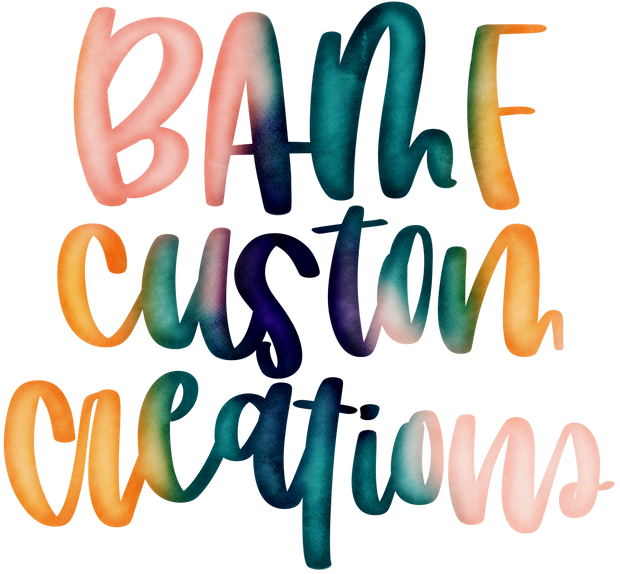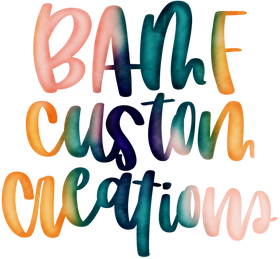Handpainted Line Floral Tumbler | How to Breakdown Material Cost
If you haven't watched the tutorial on this tumbler, check it out here.
As I was breaking down the costs of this tumbler to be able to write this blog, I was thinking about how I break it down and figured I would explain in detail how you can break down the cost of your materials.
I am still working on a new version of the Tumbler Excel Profit/Material Cost Spreadsheet, but in the mean time, let's break it all down.
What I do want to bring to light is what you can consider apart of your material cost for creating your tumblers, and what you can leave out.
For example, you do not need to include the packaging cost, but I do feel this is important cost to breakdown: 1. because it is good to know how much you are spending on packaging per item, 2. because shipping is an expense, whether you are paying for it in order to offer free shipping or your customer pays shipping, & 3. packaging is still apart of the cost, and should be included.
Another point, is some items may be difficult to break down, and can just be considered as supplies in your general business. For example, the paint pens can be difficult to break down, which is what I realized in this breakdown. So not including the cost of the pens in this is ok with me, especially because my time spent using the pens very much makes up for the cost of the pens.
The first thing I do is break the amount of materials down and try and get them to consistently be in the same measurement/unit.
With this tumbler i used Pop of Color paints. I bought these paints in the 4 oz increments and then broke the ounces down to mL(which I use google conversions for this). 4 oz = 118.294. If 4 oz of the Pop of Color paint is $7.95 for 4 oz then you would do: $7.95 / 118.294 mL = $0.07 per mL. If I used approximately 25 mL per color and I used 7 colors: then I used $11.76 in Pop of Color paints. This is including any waste, since it cannot be used any further but was intended to be used for this project.
To break down the cost of spray paint, you want to find out how much square coverage the spray paint covers. For example, Rust-Oleum American Accents 2x Ultra Cover 12 oz Can of Spray Paint, covers 50 square feet of area. One can costs $3.96. First I break down the coverage area: 50 square feet = 7200 inches (squared). So $3.96 / 7200 in^2 = $0.00055 per square inch.
So your tumbler can be broken down two ways to find the area, 1. the easy way of just multiplying the height and circumference (how big around the tumbler is) and that is the area. 2. there is a more complicated formula that can be used that is way more accurate, which is the surface area if a "circular truncated cone" - the calculator for this can be found here. So for this tumbler, I used a 30 oz Skinny Straight tumbler from Griffin Blanks. This tumbler is 9.5" tall and has a diameter of 3.125" and a circumference of 9.8175". To find the radius you divide the diameter by 2, so that would be 3.125 / 2 = 1.5625. The formula/calculator from the link asks for a lower and upper radius, since this is a no taper cup, you can enter 1.5625 into both. If this is a tapered cup you would fid the radius of the top and the bottom.
So after entering this data into the calculator, the surface area of a 30 oz no taper skinny from griffin blanks is 108.61 in.
Now how is the surface area of the tumbler relevant? Well, this can help you find the cost of not only spray paint but also glitter. Since we did not do full coverage of glitter on this specific tumbler, we will cover that at another time. As for spray paint. Base coating this tumbler with one coat of rustoleum spraypaint would be 108.61 in x $0.00055 = $0.06.
The last little break down I will go over is vinyl. Vinyl is fairly similar to the calculations above. You will find the total area in inches of the vinyl which will be divided by the cost of the vinyl. Let's do this with the vinyl and transfer tape used for this tumbler:
Antique Rose Pattern Vinyl from Auntie Tay is $4 for 12x12. 144 total inches squared for $4, $4 / 144 = $0.03 per square inch. a 4x4 piece of vinyl was used, making it 16 in of area. 16 x $0.03 = $0.44
Oracal 631 Matte White Vinyl was used for this. On amazon, you can get a 12' by 15 foot roll for $16.10. The total area of this roll would be 12 inches x (15 feet x 12 inches) = 2160 total inches. You then break down the cost per square inch, $16.10 / 2160 inches = $0.007 per square inch. I used a 4 x 4 piece of vinyl so it cost me (16 inches x $0.007) $0.12.
Last is the transfer tape. I use cricut transfer tape. You can purchase a 1 ft by 21 ft roll of transfer tape from amazon for $16.91. The total area of this roll is 3024. $16.91 / 3024 inches = $0.006. I used a 4 x 4 piece (16 inches total) meaning that it cost me ($0.006 x 16) 9 cents to use that transfer tape.
All of this math can be discouraging and confusing for some. And that's ok, not everyone enjoys breaking down the cost, I think it's a little weird that I do enjoy it haha. So now I will show you the list of materials I used for this project, and how much it cost me for this tumbler, as well as the calculation of the suggested retail price.
Materials Used: cents cents
- 30 oz Skinny Straight from Griffin Blanks is $7.19 (if you use discount code BAMF10 at checkout for 10% off)
- RustOleum Spray Paint 6 cents
- Pop of Color Paints (estimated use of 25 mL per color, 7 colors used) $11.76
- Paper towel & Paper plate 5 cents
- 80 total mL of CCDIY Ultra Clear Fast Set Epoxy $3.20
- 3 gloves (1 for each epoxy layer) 72 cents
- 3 mixing medicine cups 9 cents
- 3 popsicle sticks 9 cents
- 90 seconds of heat (camping gas/torch) 3 cents
- 1 gram of Brite glitter from Peachy Olive Glitter 19 cents
- 6 mL of 91% alcohol 6 cents
- 5 cotton rounds 15 cents
- 1 Wax sheet 2 cents
- Antique Rose Pattern Vinyl from the Flynn Sister collection on Auntie Tay 44 cents
- Oracal 631 Matte White Vinyl 12 cents
- Cricut Transfer Tape 9 cents
- 5 mL Acetone 5 cents
- 12 x 4 x 4 Shipping Box 83 cents
- 3 pieces of tissue paper 9 cents
- 2 sheets of bubble wrap 26 cents
- 1 care card from Vista Print 6 cents
- 1 thank you post card from Vista Print 5 cents
- 1 rollo 4 x 6 shipping label 3 cents
- 1 packing slip + ink 6 cents
- 20 inches of leopard packing tape from Package Mint 10 cents
- Packaging stickers from the Cooke Co 80 cents
Total Material Cost: $26.59
Total Active Working Time: 2.5 Hours
Hourly Rate: $12.00
[(Material Cost x 4) + (Time x Rate)] / 2
[(26.59 x 4) + (2.5 x $12)] / 2
[106.36 + 30] / 2
136.36 / 2
$68.18
The suggested retail price for this tumbler is $68.18. Again, this is a suggested price and you should take this into consideration along with your overhead costs, fees for selling as well as the market, your experience etc.
DISCLOSURE: The description and links provided may contain affiliate links and discount codes, that at no additional cost to you, may provide me with some financial compensation. I would never recommend any products or materials that I do not personally use and love. All opinions expressed by me are opinions of my own free will and are only my opinions. Tumbler


Although, I don’t sell, I was so inspired by the video, I tried it out on a mailing envelope I had nearby. Just the wiggles with a white paint pen on a brown substrate. And I was so pleased with the first result. Not very good, but it was decent. Can’t wait to keep trying. The envelope looks pretty, though.
This is amazing how you explain each of the material breakdown. Thank you! Quick question, why are you multiplying the materials by 4 and why are you dividing by 2? Just curious on the final results. I would have multiple the hour x rate and added material cost so I know I’m missing something! Thanks!!
Thank you so much for this breakdown! Wow you went into so much detail 👏🏼👏🏼 Awesome
Thank you so much for this breakdown. You put so much time and effort into this and I very much appreciate it. It helps a lot!!
Leave a comment